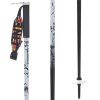Ski boots use their own sizing system called Mondopoint, which indicates the length of the foot in centimeters.
To find your correct size, measure your foot from heel to toe — the resulting length (in cm) corresponds to your Mondopoint size.
When trying on ski boots, wear thin socks.
Modern ski boots are well insulated, even in freezing conditions where a yeti would be shivering — so thick socks would only reduce your control over the skis.

ZAČÁTEČNÍK
Beginners should choose boots that match their Mondopoint size. Keep in mind that ski boots expand slightly with use, which creates more room around the foot and reduces control. That’s why you shouldn’t size up — the boot will naturally loosen over time.
 Intermediate
Intermediate
Intermediate skiers should go for boots that are slightly smaller than their Mondopoint size and choose a stiffer flex for better performance. However, comfort still comes first — don’t sacrifice it completely for precision.
 Expert
Expert
Advanced and expert skiers should choose boots that are a bit smaller than their actual foot length in cm for maximum energy transfer to the snow. The flex should be stiff to very stiff. For extra comfort, boots can be heat-molded (custom-fitted) by a bootfitter, allowing a perfect fit inside the shell.
 Precise Fitting
Precise Fitting
To fine-tune your fit, you can remove the liner from the boot shell and slide your foot forward until your toes just touch the front. This leaves space behind your heel — you can check it by inserting your hand or a small block of wood to see how much room you have. That tells you whether the boot has too much or too little space for your foot.
A slight pressure on the toes usually means the size is right — as long as the pressure comes from the liner and not the hard shell. If you feel pressure in the front, bend your knees forward to push your heel back; the pressure on your toes should ease. If it doesn’t, the boot can be heat-expanded by a bootfitter. Remember: a ski boot can always be stretched to make it larger, but it cannot be made smaller.














